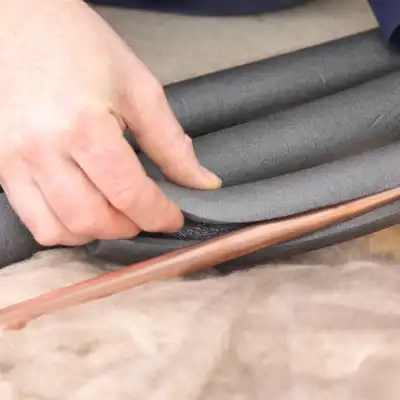The best part of hiring one of our handymen is that we can perform a wide variety of jobs around the house when we show up—including both minor and major services. Not only can we insulate your pipes, but we can insulate other areas of your home (such as windows and attic) and perform repairs, replacement, and installation for everything from toilets to faucets and showerheads. No job is too small for our team!
FAQs and Answers
Mr. Handyman has been helping homeowners repair, maintain, and enhance their spaces for over 25 years! We are the one-stop solution for everything on your to-do list. This includes answering your questions about home repairs, maintenance, and improvements. Here are answers to some of your most frequently asked questions about Pipe Insulation Services.
What type of insulation is best for pipes?
There are a few different types of pipe insulation, including:
- Rubber insulation
- Mineral wool
- Foam pipe insulation
- Fiberglass
- Foil pipe insulation wrap
Polyethylene foam pipe insulation is considered to be the most efficient form of pipe insulation. It can be easily installed on any type of pipe and has the highest R-value, which means it’s the best solution for keeping pipes warm. If your main concern is keeping your pipes from freezing, rubber insulation might be the best option since it’s made to adapt to quickly changing temperatures.
Does pipe insulation stop freezing?
Yes, pipe insulation can stop your pipes from freezing. However, pipes in areas that are unheated, like your attic, garage, or basement, are still vulnerable to cracking. It’s a good step in the right direction, but you’ll also need to mitigate that risk by improving the overall heat in these areas. For complete freeze protection, you can also use heat or electrical tape, seal any air leaks that might be letting cold air in near your pipes, allow the faucets to drip, and maintain a consistent indoor air temperature.
Are pool noodles the same as pipe insulation?
Pool noodles and foam pipe insulation are both made of polyethylene, but pool noodles actually have a different composition, making them different in terms of insulation. The pool noodles are generally thicker and have air pockets that affect the R-value, providing less insolation than foam pipe insulation. Lastly, the foam pipe insulation comes pre-fit to pipes and fits snugly around them to control the varying temperatures better. Pool noodles simply aren’t designed for this purpose. Pool noodles are cheaper and can be a temporary fix, but for long-term insulation, go with the foam pipe insulation.
What is the best way to insulate pipes?
You’ll need to consider the climate, type of pipe, and what insulation material is available to you. Foam is a common and inexpensive option, and most installations can be done on your own. However, the foam will degrade over time and isn’t the best option for hot water pipes.
Once you’ve chosen your material, apply it to all of your exposed pipes, and then add a heat table or heat cables for full coverage. Make sure you seal any insulation ends or air leaks near the pipes to avoid any drastic temperature shifts.
What can be used as pipe insulation?
If you need water pipe insulation, consider using foam rubber, polyethylene foam, or fiberglass. The foam is flexible and is effective for cold water pipes because it can resist condensation. It promotes energy efficiency and is also resistant to mold. Polyethylene foam is great indoors, affordable, and resistant to moisture. If you choose fiberglass, it comes with a built-in vapor barrier and is wrapped in foil. This material is perfect for high-temperature or outdoor piping. It is built to withstand extreme temperatures while providing good thermal insulation. Because of the vapor barrier, you can also use it in humid environments, like in your bathroom.
All Mr. Handyman franchises are locally owned and operated and may offer fewer or more services than those listed here. To learn more about Pipe Insulation Services offered in your area, contact your local Mr. Handyman for details or a customized on-site assessment.
 Click to call
Click to call


 Click to call
Click to call
